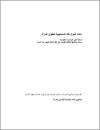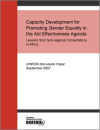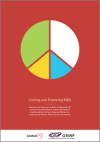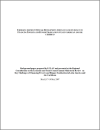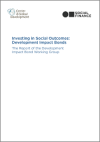FOUND 113 RESULTS
The report, authored by Professor Diane Elson, a leading feminist economist, makes a significant contribution to the advocacy work on the transparency of budgets. It provides arguments for increasing the accountability of government budgets to women's rights.
Budgeting for Women's Rights Monitoring Government Budgets for Compliance with CEDAW: summary..(Fr )
A summary guide for policy makers, gender equality and human rights advocates" is a publication based on a report by Diane Elson "Budgeting for Women's Rights: Monitoring Government Budgets for Compliance with CEDAW" by UNIFEM 2006. The publication developed by UNIFEM in 2008 articulates what it means to take an explicitly rights-based approach to government budgets and draws on the lessons of Gender Budgets Initiatives (GBIs) experiences around the world. It links governments' commitments under...
A summary guide for policy makers, gender equality and human rights advocates" is a publication based on a report by Diane Elson "Budgeting for Women's Rights: Monitoring Government Budgets for Compliance with CEDAW" by UNIFEM 2006. The publication developed by UNIFEM in 2008 articulates what it means to take an explicitly rights-based approach to government budgets and draws on the lessons of Gender Budgets Initiatives (GBIs) experiences around the world. It links governments' commitments under...
This discussion paper was prepared following UNIFEM's sub-regional Consultations on gender equality and aid effectiveness held in various countries in Africa in 2006-2007 (Burundi in July 2006, Djibouti in November 2006, Ghana in November 2006 and Zambia in July 2007). The consultations brought together representatives from governments, donor partners and civil society to share experiences and explore strategies for advancing gender equality goals in the new aid environment. Participants...
Examining the resources needed to implement Security Council Resolution 1325 at national level as well as the gains, gaps and glitches of financing the women peace and security agenda. Over the last decade the policy environment on women, peace and security has gained significant momentum. The adoption of UN Security Council Resolution 1325 in 2000, the recent adoption of subsequent resolutions 1820, 1888 and 1889 and now the development of indicators for tracking the implementation of 1325 call...
Since the start of the COVID-19 pandemic, almost USD 16 trillion has been pumped into the global economy, and governments are now rolling out second and third phases of support. With the introduction of vaccines, some countries can begin to get the pandemic under control and start investing in recovery. Most countries, however, are still grappling with the pandemic’s immediate health and socio-economic fallout, including its outsized impact on women. While the adoption of policy measures...
Recent reforms of aid delivery, most notably the Paris Declaration on Aid Effectiveness (2005), have provided new opportunities and mechanisms to translate donor and government commitments into improved practice results and impacts. Achieving internationally agreed development goals will however not be possible without progress on gender equality and women's empowerment. A the same time, implementing the Paris Declaration's overarching partnerships commitment is a powerful way of accelerating...
Paper discussing the definition and measurement of Sustainable Development Goal (SDG) Indicator 5.c.1 (reclassified to Tier II) and discussing the relationship of SDG Indicator 5.c.1 with other Indicators.
This background paper was prepared by ECLAC and presented at the Regional Consultations on the Economic and Social Council Annual Ministerial Review on Key Challenges of Financing Poverty and Hunger Eradication in Latin America and the Caribbean, held in Brazil, 17-18 May 2007. This document analyses the challenges for development finance posed by current ODA trends. It also presents and examines the new financial instruments being proposed. The focus is on the Latin American and Caribbean...
This practical guide by Debbie Budlender and Guy Hewitt, based on experiences of past gender budget initiatives, provides a comprehensive outline of how to engender budgets. Intended for practitioners of any level, this gender budgets handbook provides insight based on past examples, while also relaying technical guidance needed to apply the concepts in most contexts.
